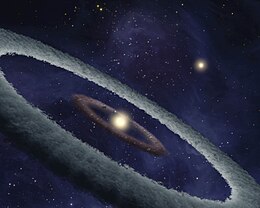NASA says star system contains 'earth-like planet' in the making
Thursday, October 4, 2007

Image: NASA/JPL.
NASA scientists have stated that an "earth-like" planet is currently forming in a star system's 'habitable zone' just over 400 light-years from Earth. The new discovery was made by NASA's Spitzer Space telescope.
According to scientists, dust and rock orbiting a ten million year old star in the system HD 113766 contains "enough [material] to build a Mars-size planet or larger."
"The timing for this system to be building an Earth is very good. If the system was too young, its planet-forming disk would be full of gas, and it would be making gas-giant planets like Jupiter instead. If the system was too old, then dust aggregation or clumping would have already occurred and all the system's rocky planets would have already formed," said NASA scientist Carey Lisse from the Johns Hopkins University Applied Physics Laboratory located in Baltimore, Maryland.

(Image missing from Commons: image; log)
Lisse states that the dust and rock, which was examined by the telescopes infrared spectrometer instrument, is more processed than the snowball-like stuff that makes up infant solar systems and comets, which are considered cosmic "refrigerators" because they contain pristine ingredients from the early solar system, but he also says that the material is not quite ready to form an actual planet, meaning that the material is currently in a "transitional phase" or in a phase just before a planet begins to form.
The dusty material Lisse says, does not contain "any water ice, carbonates, or fragile organic materials," making the star system a fairly young celestial body.
"The material mix in this belt is most reminiscent of the stuff found in lava flows on Earth. I thought of Mauna Kea material when I first saw the dust composition in this system - it contains raw rock and is abundant in iron sulfides, which are similar to fool's gold," said Lisse. Mauna Kea is a well-known volcano in Hawaii.
Scientists remain excited knowing that they have the chance to observe a planet forming right before their eyes. "It is fantastic to think we are able to detect the process of terrestrial planet formation. Stay tuned - I expect lots more fireworks as the planet in HD113766 grows," added Lisse.
Sources
- "Earth-Like Planet Spotted in the Making" — Scientific American, October 4, 2007
- "Star System 'Just Right' for Building an Earth" — NASA, October 3, 2007
| |
This page has been archived by an administrator, and sighted by a trusted user. It is no longer publicly editable.
Got a correction? Add the template {{editprotected}} to the talk page along with your corrections, and it will be brought to the attention of the administrators. Please note that the listed sources may no longer be available online. The sighting of this article does not guarantee accuracy - it has been sighted for technical reasons. |

